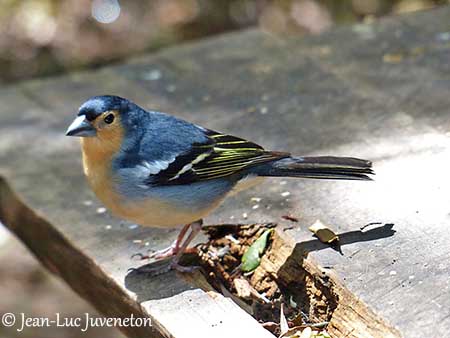
Common Chaffinch
Fringilla coelebs
Passeriforme Order – Fringillidae Family
BIOMETRICS:
Length : 14-16 cm
Weight : 20-24 g
LONGEVITY: up to 12 years
DESCRIPTION:
Common and familiar, the Common Chaffinch lives close to humans in the most part of its range.
Adult male is relatively large.
Upperparts are soft reddish-brown on back, whereas the rump is green. Upperwing is black with two conspicuous white bars, and buffy-white edges to flight feathers. The tail is black with white outer rectrices.

Underparts are pinkish-brown. Vent and undertail coverts are whitish.
On the head, forehead is blackish. Crown, nape and neck sides are grey. Cheeks and ear-coverts are pinkish-brown, as underparts.
In winter plumage, Chaffinch male has same pattern but duller plumage.
The pointed bill is greyish-blue in breeding plumage, and rather pinkish in winter. Eyes are dark brown. Legs and feet are pinkish-brown.
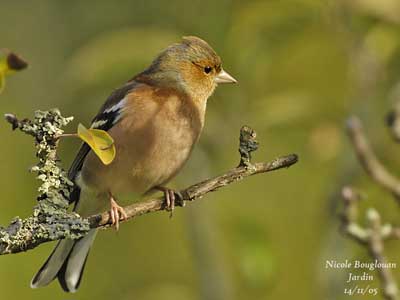
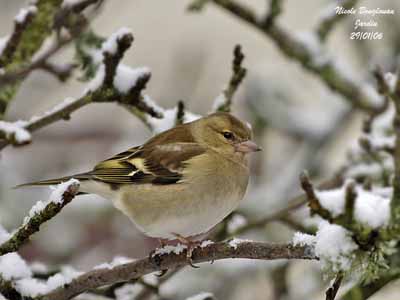
The adult female is duller, with greyish-brown plumage, paler on the underparts. The wing-bars are creamy-white and narrower than in male.
Head is brownish with paler nape patch. Bill is pale pink with blackish tip. The dark eyes are bordered by buffy-white feathered eye-ring.
The juvenile resembles female.
We can find several subspecies. Here are some examples:
F.c. coelebs, from most part of Northern Europe. Male is more coloured.
F.c. spodiogenys, from Tunisia. It is paler than other races.
F.c. palmae, from Las Palmas (Gran Canaria – Spain).
F.c. madeirensis, from Madeira. Male is bluish-grey with green tinge on the upper back.
F.c. africana, from North Africa. It has green back.
F.c. canariensis, from Canary Islands. It has dark bluish-grey back.
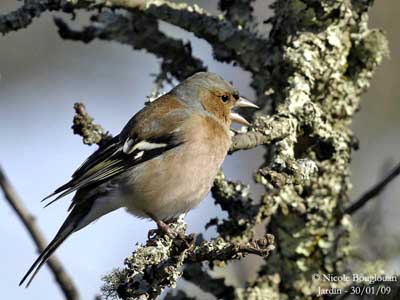
HABITAT:
Common Chaffinch is found in various kinds of woodlands, as deciduous or coniferous. It prefers open woodlands, and it is very common in parks and gardens, cultivated areas, orchards and hedgerows.
Outside the breeding season, it performs some dispersion and frequents open farmlands.
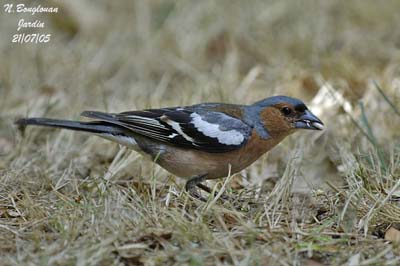
RANGE:
Common Chaffinch is found throughout Europe. It lives from Western Europe to Western Asia, Middle-East, North Africa and the Macaronesian Islands in Atlantic Ocean.
BEHAVIOUR:
Common Chaffinch feeds in large groups in winter, taking seeds in farmlands and gardens. But in breeding season, this bird is strongly territorial. They usually feed on the ground and often mix with other Fringillidae and Sparrows. It walks on the ground with fast and short steps, hops, and flies from tree to tree.

This species is resident or partially migratory according to the range. Birds of the northern parts of the habitat move southwards in winter.
Territory is occupied in January by oldest males. The youngest birds establish their territory in February or later. The young male moves carefully between the tree branches, while giving the typical “pink-pink”. It frequently comes to the ground for feeding.
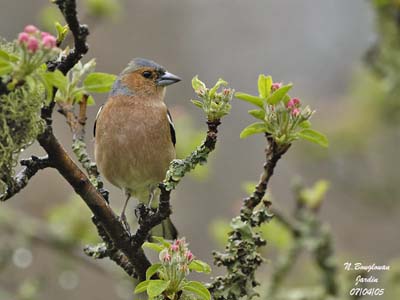
Common Chaffinch usually returns to the same territory every year. Male is very aggressive, chasing away intruders or other birds.
Female arrives in March. Mates stay together about six weeks before to breed. The male performs courtship displays but the female may be aggressive towards him. However, they feed together on the ground.
FLIGHT:
Common Chaffinch performs undulating flight. It hovers before to alight, displaying the white patches of wings and tail.
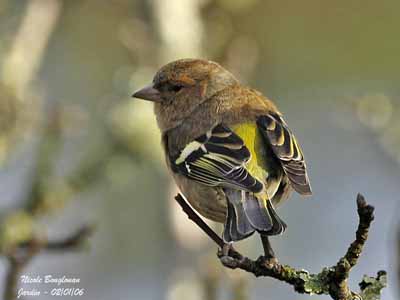
REPRODUCTION:
Breeding season starts in April, but may vary according to the range.
The nest is built by the female alone, and placed in fork in tree or in thick bush. This cup-shaped nest is very beautiful, made with lichen and moss which provide an excellent camouflage, and some bark chips are added too. The interior is lined with hair and feathers.
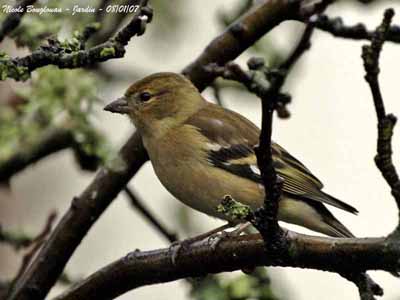
Female lays 4 to 5 pale blue eggs with pink, reddish or purple markings. Incubation by female alone lasts about 11 to 13 days.
At hatching, the chicks are covered with thick, long, pale grey down. They are fed by both adults, mainly with insects. They leave the nest 13 to 14 days after hatching, and still depend on parents for about 15 to 20 days, until they are able to feed and fly.
This species produces one brood per year, sometimes two.
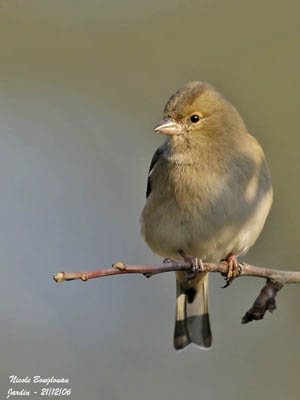
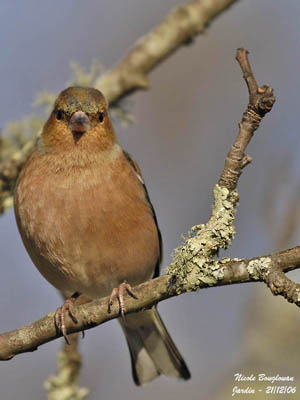
DIET:
Common Chaffinch feeds mainly on seeds taken on the ground, but it also consumes insects, spiders and earth worms, and some fallen fruits such as apples.
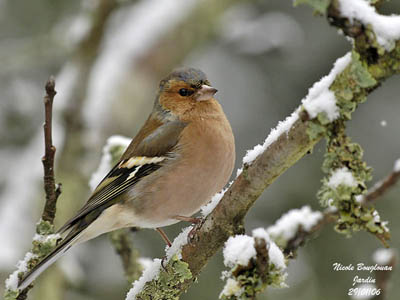
PROTECTION / THREATS / STATUS:
Common Chaffinch is very common and widespread in its range.
It may be vulnerable to pesticides and herbicides included in the seeds.
Domestic cats are their main predators.
However, populations are not threatened at this moment.
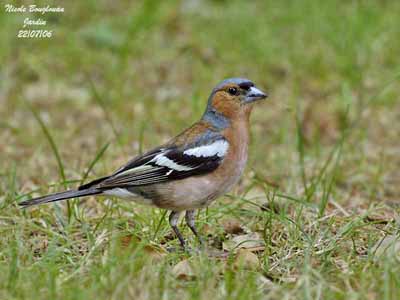
Fr: Pinson des arbres
All : Buchfink
Esp : Pinzón Vulgar
Ital : Fringuello comune
Nd : Vink
Russe : Зяблик
Sd: Bofink
Picture of the subspecies "canariensis " by Jean-Luc Juveneton
Text and pictures by Nicole Bouglouan
Sources :
L’ENCYCLOPEDIE MONDIALE DES OISEAUX - Dr Christopher M. Perrins - BORDAS - ISBN: 2040185607
THE COMPLETE BOOK OF BRITISH BIRDS – Written by “Royal Society for the Protection of Birds” experts - Préface de Magnus Magnusson - Michael Cady- Rob Hume Editors - ISBN: 0749509112
THE HANDBOOK OF BIRD IDENTIFICATION FOR EUROPE AND THE WESTERN PALEARCTIC by Mark Beaman, Steve Madge - C.Helm - ISBN: 0713639601
Pájaros de España (JL Beamonte)
Wikipedia (Wikipedia, The Free Encyclopedia)
